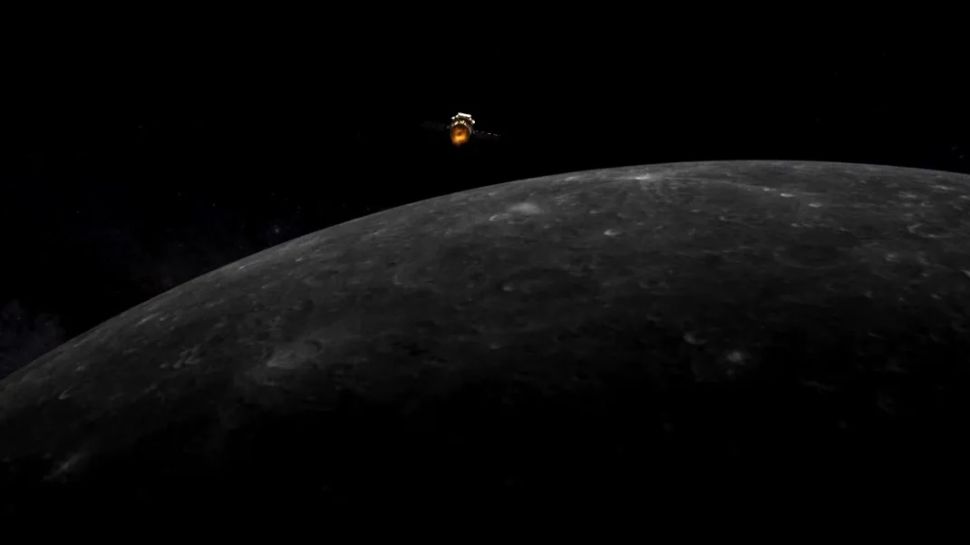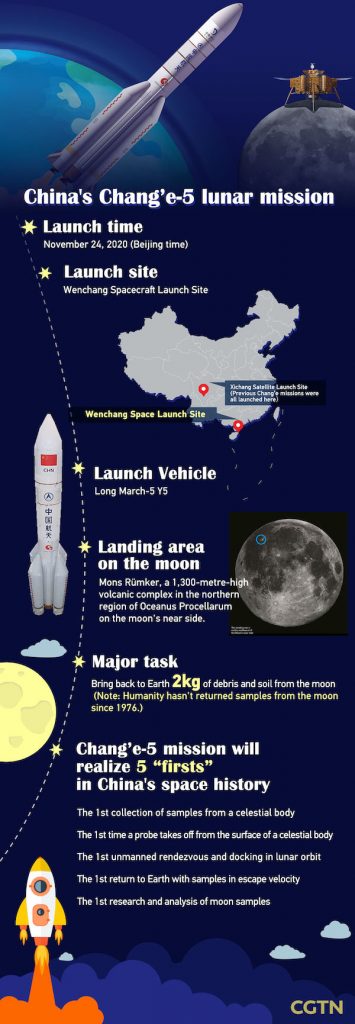

Artist’s concept of Chang’e 5 entering lunar orbit. It’s China’s 1st moon-sample-return mission and the 1st for the world at large since 1976. Image via China Lunar Exploration Project.
After a journey lasting 112 hours, the Chang’e 5 spacecraft is now reported by space engineers in China to have entered orbit around the moon. The robotic mission is the first lunar sample-return mission since the 1970s. It launched last week (November 23, 2020) from the Wenchang Space Launch Center in China’s Hainan province, rising into the sky atop a Long March 5 rocket. The China Lunar Exploration Program said earlier today:
At 20:58 on November 28, the Chang’e-5 probe flew to the moon for about 112 hours and successfully ignited a 3000 N engine at a distance of 400 kilometers [248 miles] from the lunar surface. About 17 minutes later, the engine shut down normally. According to the monitoring and judgment of real-time telemetry data, the Chang’e-5 probe braked normally in recent months and entered the orbit around the moon smoothly.
If all goes according to plan, the new and ambitious Chang’e 5 will haul pristine moon samples back to Earth in mid-December, something that hasn’t been done since the Soviet Union’s Luna 24 mission in 1976.

The mission, named after the ancient Chinese goddess of the moon, will seek to collect lunar material to help scientists understand more about the moon’s origins and formation. Image via China Global Television Network.
Although Chinese officials have been characteristically vague about Chang’e 5’s details, we know the short mission will be action-packed. The 18,100 pound (8,200 kg) spacecraft is expected to send two of its four modules – a lander and an ascent vehicle – to the lunar surface within the next day or two. The mission will land in the Mons Rumker area of the huge volcanic plain Oceanus Procellarum (translated from Latin to English as Ocean of Storms). Portions of this region on the moon have been explored by a number of other surface missions, including NASA’s Apollo 12 in 1969.
The stationary lander will study its environment with cameras, ground-penetrating radar, and a spectrometer, but its main job is to snag about 4.4 pounds (2 kg) of lunar material, some of which will be dug from up to 6.5 feet (2 meters) underground. This work will be done over the course of two weeks, or one lunar day. That is a firm deadline, given that the Chang’e 5 lander is solar-powered and won’t be able to operate once night falls at its location.
Mons Rumker harbors rocks that formed just 1.2 billion years ago. In contrast, the moon rocks brought home by the Apollo astronauts between 1969 and 1972 are considerably older. The Planetary Society, a nonprofit space advocacy program, explained:
The samples should be the youngest ever returned to Earth: just 1.2 billion years old, when multicellular life may have already evolved on our planet. Chang’e-5 will help scientists understand what was happening late in the moon’s history, as well as how Earth and the solar system evolved.

This image of Mons Rumker on the moon was captured by Apollo 15 astronauts in 1971. It is about 43 miles (70 km) wide and rises nearly a mile (1.6 km) above the surrounding area. Image via Planetary Society.
China is often said to have been late to the space race. It didn’t send its first satellite into orbit until 1970, by which time the U.S. had already landed an astronaut on the moon. But China has caught up fast. Supported by billions of dollars in government investment, China has rapidly accelerated its space program over the past decade, firing space labs and satellites into orbit.
China launched the Chang’e 1 and Chang’e 2 orbiters in 2007 and 2010 respectively, and the Chang’e 3 lander-rover duo that touched down on the moon’s near side in December 2013. Sadly, the Chang’e 3 rover died after 31 months of work on the lunar surface when the rover became unresponsive to calls from the ground, although not before surpassing its intended lifetime and setting a new record for the longest operating rover on the lunar surface. The Chang’e 3 rover, like all other rovers, was designed to move and explore the surface whereas its lander, which is still going strong, was built specifically to stay in place without roaming around. And in January 2019, Chang’e 4 became the first mission ever to ace a soft landing on the moon’s mysterious far side. Chang’e 4 is still currently in operation.
Chang’e 5 is part of a recent surge in sample-return missions. On December 6, 2020, for example, pieces of the asteroid Ryugu collected by Japan’s Hayabusa2 mission are scheduled to touch down in Australia. More recently, NASA’s OSIRIS-REx probe snagged a hefty sample of the asteroid Bennu; that material will come down to Earth in September 2023, if all goes according to plan.
Speaking to astronauts aboard the Shenzhou 10 spacecraft through a video call in 2013, Chinese president Xi Jinping said:
The space dream is part of the dream to make China stronger. The Chinese people will take bigger strides to explore further into space.
Last year, China also became the first country to send an unmanned rover to the far side of the moon. And in July this year, China launched its first unmanned mission to Mars: the Tianwen-1 probe, which will orbit the planet before landing a rover on the surface; it’s expected to reach the red planet next February. If Tianwen-1 is successful, Beijing has plans to eventually send a manned mission to Mars. Plans are also underway to launch a permanent space station by 2022, and send astronauts to the moon by the 2030s.
If successful, China would become only the second country, after the U.S., to put a citizen on the moon.
Bottom line: China’s robotic Chang’e 5 mission launched from the Wenchang Space Launch Center of China’s Hainan province, rising into the sky atop a Long March 5 rocket at about 3:30 p.m. EST (20:30 UTC) on November 23, 2020. If all goes according to plan, the new and ambitious Chang’e 5 will haul pristine moon samples back to Earth in mid-December, a feat not accomplished since the Soviet Union’s Luna 24 mission in 1976.
Read more from The Guardian: China launches Chang’e-5 mission to bring back rocks from moon
Read more from Scientific American: China’s Chang’e-5 Mission Launches to Collect Lunar Samples
Source:
https://earthsky.org/space/china-moon-mission-change-5-sample-return